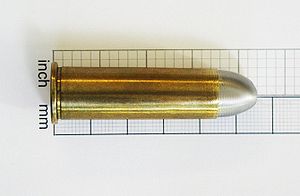.50-70 Government
| .50-70 Government | ||||||||||||||||
|---|---|---|---|---|---|---|---|---|---|---|---|---|---|---|---|---|
 |
||||||||||||||||
| Type | Rifle | |||||||||||||||
| Place of origin | USA | |||||||||||||||
| Service history | ||||||||||||||||
| In service | 1866-1873 | |||||||||||||||
| Used by | USA | |||||||||||||||
| Production history | ||||||||||||||||
| Designed | 1866 | |||||||||||||||
| Specifications | ||||||||||||||||
| Case type | Rimmed, straight | |||||||||||||||
| Bullet diameter | .515 in (13.1 mm) | |||||||||||||||
| Neck diameter | .535 in (13.6 mm) | |||||||||||||||
| Base diameter | .565 in (14.4 mm) | |||||||||||||||
| Rim diameter | .660 in (16.8 mm) | |||||||||||||||
| Rim thickness | .065 in (1.7 mm) | |||||||||||||||
| Case length | 1.75 in (44 mm) | |||||||||||||||
| Overall length | 2.25 in (57 mm) | |||||||||||||||
| Primer type | Large rifle | |||||||||||||||
| Maximum pressure | 22,500 psi (155 MPa) | |||||||||||||||
| Ballistic performance | ||||||||||||||||
|
||||||||||||||||
|
Test barrel length: 28" Source(s): Accurate Powder |
||||||||||||||||
The .50-70 Government cartridge was a black powder round adopted in 1866 for the Springfield Model 1866 Trapdoor Rifle.
The cartridge was developed after the unsatisfactory results of the .58 rimfire cartridge for the Springfield Model 1865 Trapdoor Rifle.
The .50-70 Government cartridge became the official cartridge of the US military until replaced by the .45-70 Government in 1873. The .50-70 cartridge had a pressure limit of 22,500 PSI.
The official designation of this cartridge at the time of introduction was "US Center-fire Metallic Cartridge", and the commercial designation .50-70-450, standing for :
Caliber .50
Powder Charge 70 grains (4.5 g) black powder
Bullet Weight 450 grains (29 g)
Since this cartridge is no longer commercially produced, reloaders have experimented with a variety of bullet weights from 425 to 600 grains (39 g) in weight. There is evidence that a reduced load version of this cartridge was officially produced for use in Sharps carbines converted to metallic cartridge ammunition, as well as cadet rifles. This used a 430-grain (28 g) bullet and 45 grains (2.9 g) of powder.
Buffalo Bill Cody used a Springfield Model 1866 in caliber .50-70 while hunting buffalo to feed the track workers of the Kansas Pacific Railroad (later Union Pacific Eastern Division).
...
Wikipedia
